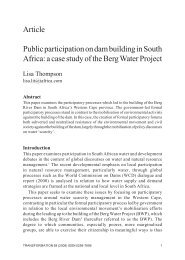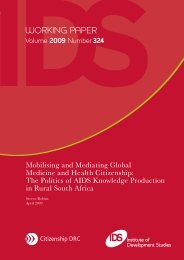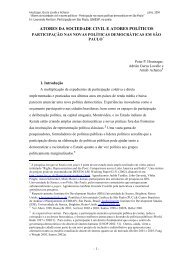Associations and the Exercise of Democratic ... - Citizenship DRC
Associations and the Exercise of Democratic ... - Citizenship DRC
Associations and the Exercise of Democratic ... - Citizenship DRC
You also want an ePaper? Increase the reach of your titles
YUMPU automatically turns print PDFs into web optimized ePapers that Google loves.
IDS WORKING PAPER 285Associational participation, however, is itself highly stratified along socioeconomiclines in São Paulo. It is far less so in Mexico City. The descriptivestatistics earlier in <strong>the</strong> paper already suggested that associational participation ishighly stratified along socio-economic lines. Here we use multivariate models(probits) for associational participation in São Paulo <strong>and</strong> Mexico City to calculate<strong>the</strong> average proclivity <strong>of</strong> a person, with a particular characteristic, such as lowleveleducation, to participate in associations (Tables B.3 <strong>and</strong> B.4, Appendix B). ForSão Paulo we are able to identify robust determinants, but not in <strong>the</strong> case <strong>of</strong>Mexico City.The unequal distribution <strong>of</strong> associational participation across social strata – basedon education, gender, <strong>and</strong> labour market status – appears to limit <strong>the</strong> overallreduction in <strong>the</strong> impact <strong>of</strong> socio-economic stratification on civil relations in SãoPaulo. In Mexico City associational participation is likely to be distributed r<strong>and</strong>omlyacross <strong>the</strong> factors we have examined – that is, education, gender, labour marketinsertion, as well as by religion <strong>and</strong> some regions <strong>of</strong> <strong>the</strong> city.Education-based stratification in associational participation is especially severe in<strong>the</strong> Brazilian city (Table B.3). The share <strong>of</strong> <strong>the</strong> well educated (with some highereducation) who participate in associations is three times that <strong>of</strong> people with littleeducation. On average only 14 per cent <strong>of</strong> people with little education willparticipate in associations, while 43 per cent <strong>of</strong> people with some higher educationwill participate. There is fur<strong>the</strong>r a substantial difference by income <strong>and</strong> by form <strong>of</strong>labour market participation. Holding education constant, nearly half <strong>of</strong> <strong>the</strong> peoplewho are formally employed <strong>and</strong> <strong>of</strong> <strong>the</strong> high income earners have proclivity toparticipate in association. In contrast, only 28 per cent <strong>of</strong> people employed in <strong>the</strong>informal sector <strong>and</strong> only 20 per cent <strong>of</strong> those with <strong>the</strong> lowest level <strong>of</strong> income willhave any associational participation. In Mexico City <strong>the</strong>re is no evidence <strong>of</strong>education-based stratification (Table B.4).Taking into account both <strong>the</strong> larger citizenship effect people with low educationalattainment or outside <strong>of</strong> <strong>the</strong> labour market obtain from participation, <strong>and</strong> <strong>the</strong>stratification <strong>of</strong> associational participation, how likely are such individuals to beactive citizens, to attempt to mobilise government, or to have direct civil relationsto government? In São Paulo <strong>the</strong> share <strong>of</strong> population that has little education butparticipates in associations, <strong>and</strong> are consequently active citizens is only 6.8 per cent,<strong>the</strong> share that mobilise government is 6.1 per cent <strong>and</strong> <strong>the</strong> share that direct civilrelations 2.7 per cent (Tables B.3 <strong>and</strong> B.4). In sharp contrast, <strong>the</strong> share for <strong>the</strong>population with some higher education <strong>and</strong> associational participation who areactive, mobilise government <strong>and</strong> have direct relations is, respectively, 25.3 per cent,23.6 per cent <strong>and</strong> 6.8 per cent. 44Associational participation appears to produce to a gender gap where none existsin <strong>the</strong> general population. That is, women <strong>and</strong> men see a similar increase in activecitizenship in <strong>the</strong> two cities when <strong>the</strong>y participate in associations, but men are farmore likely to participate in associations <strong>and</strong> capture this benefit than women. In44 The low-values for direct relation reflect <strong>the</strong> weakness <strong>of</strong> <strong>the</strong> multivariate model.38





